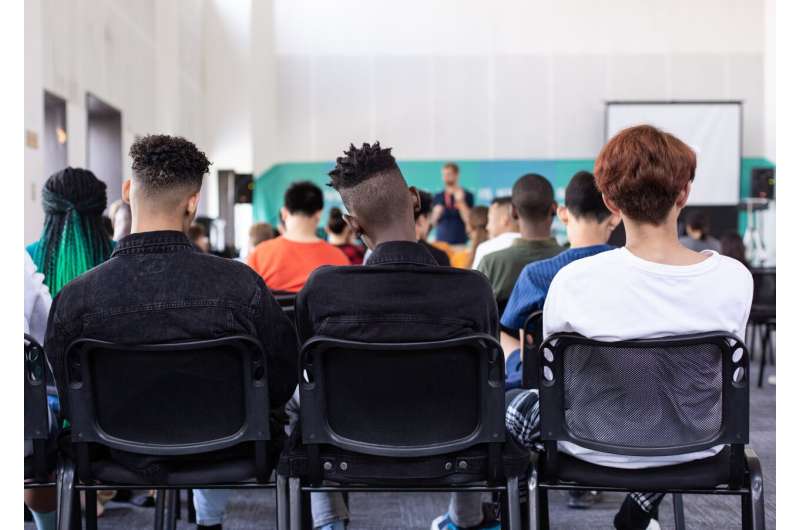This article has been reviewed according to Science X's editorial process and policies. Editors have highlighted the following attributes while ensuring the content's credibility:
fact-checked
trusted source
proofread
Social robots leave students wanting, education researchers find

Social robots, artificial intelligence (AI) systems designed to interact with humans, are marketed as capable of fulfilling certain human roles. Elementary and middle school students who interacted with one of these robots in the classroom for 10 weeks showed curiosity about aspects of the robot—including gender identity—that make them appear "social," according to Penn State College of Education researchers.
To see how long-term exposure affects students' conceptions of robots, the researchers used a social robot at a public elementary/middle school in a study published in the Journal of Computer Assisted Living. Initial excitement waned when the students thought the robot failed to meet their expectations, the researchers said, but exposure to the robot revealed the complexity of young adolescent beliefs about robots as social actors and encouraged their creative problem-solving.
"Students received realistic exposure to working advanced, autonomous technology," said Gerald LeTendre, the Harry Lawrence Batschelet II Chair of Educational Administration in the College of Education and corresponding author on the paper. "All of us are increasingly dealing with technology and AI in our daily lives. I think it's helpful for the students to see what the true capabilities of this technology are."
LeTendre and Raisa Gray, a doctoral candidate in the educational leadership program in the College of Education and co-author on the paper, introduced a social robot into a project-based learning environment at a public elementary/middle school.
"That setting really contributed to that 'in-the-wild' feeling," Gray said.
"In-the-wild" is a term robotics researchers use to describe students and robots interacting with minimal restrictions.
"The social robot is housed in this classroom where you'd be able to see students interact with it in a very organic way," Gray said.
The researchers deployed the robot in a 10-week project-based learning unit. While this was an exploratory study with no specific questions or hypotheses, LeTendre said, the overall goal was to see what happens "when you actually put this robot into a real-life classroom where there's no parameters on what the kids can do and no extensive team backing up the robot to make it perform better."
They introduced the robot to a class consisting of 16 boys and nine girls ranging in ages from 11 to 14. The students began their project by researching robots, either real or fictional. The researchers made weekly visits to observe the student interactions with the robots. They also conducted focus-group interviews that they later transcribed and coded. They analyzed the data to determine how the students interacted with and thought about the robots.
"Although most public schools are not equipped to incorporate technology like social robots as well as our study classroom, the findings suggest that these AI systems may be useful tools that can enhance technology education and problem-solving skills," LeTendre said.
According to LeTendre, the students' use of gender pronouns in reference to the robot fluctuated with context.
"So, when the students were talking about the robot and programming and its robotic existence, they tended to de-genderize it and say 'it,'" LeTendre said. "When they were talking about interaction in the classroom, they frequently used a feminine pronoun."
Despite having a humanoid form, the robot's inability to shake hands or even navigate in open areas of the classroom negatively impacted the students' perceptions of the robot as a social being. Another complaint among students was that the robot did not tailor its speech to individual conversations.
However, Gray said, those stumbling blocks turned out to be useful in the school's project-based learning environment, which prioritizes real-world experiences.
"The tech glitches enabled students to solve problems—that's what we like in a project-based learning environment," she said. "Some of these glitches that students encountered provided more of a way for them to deal with these problems."
Combining other technologies with social robots may expand their usefulness, according to LeTendre and Gray. One of the downfalls students noted was the lack of a personalized, human-like response to their conversation starters. LeTendre suggested increasing access to programs like ChatGPT, an AI program that generates tailored content based on human prompts, offers the potential to significantly enhance the communication capacity of social robots.
Although current technology and the high price tag attached to social robots limits the ability of robots to be widely deployed in public-school classrooms, LeTendre said, skillfully designed programs using social robots have the potential to motivate and engage students. Schools that use a project-based model or have a particular technological focus may be able to utilize the robot if they tailor curriculum to a robot's abilities and limitations, and the problems it poses in the classroom.
"You need to provide students with the right learning environment so that they can take full advantage of learning about social robots," LeTendre said.
More information: Gerald K. LeTendre et al, Social robots in a project‐based learning environment: Adolescent understanding of robot–human interactions, Journal of Computer Assisted Learning (2023). DOI: 10.1111/jcal.12872
Provided by Pennsylvania State University



















